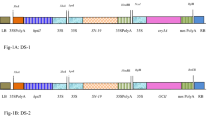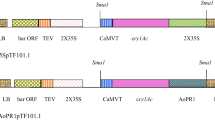Abstract
The expression of insecticidal genes must be induced at appropriate time and in sufficient amount to confer protection against targeted pests. However, the increased scientific reports of resistance development in insect pest against insecticidal delta-endotoxins, produced by Bacillus thuringiensis, provide impetus for the development of alternative insect management strategies. The present study was conducted to investigate the importance of targeted expression of a hybrid insecticidal gene (SN19) in potatoes. For this purpose, two plant expression vectors were constructed by cloning hybrid SN19 gene (cry1Ba-domain I–III and cry1Ia-domain II) under the control of a wound-inducible promoter isolated from Asparagus officinalis (AoPR1) and CaMV 35S promoter, and were transferred to Agrobacterium tumefaciens strain EHA 105. Four potato genotypes (Marabel, Innovator, Tokat 10/1 and Tokat 6/24) were transformed with EHA 105 strain harboring pTF101.1 35S–SN19 and pTF101.1 AoPR1–SN19 constructs. Phosphinothricin (PPT) was used at concentration of 1 mg/l for selection of primary transformants. PCR results showed the presence of both introduced SN19 and bar genes in 43 plants out of total 154 putative transgenics. Expression of SN19 protein in primary transformants was confirmed by Western blot assays. The mechanical wounding of transgenic plants exhibited more accumulated levels of SN19 proteins during post wounding period. Leaf biotoxicity assays with Colorado potato beetle (Coleoptera) and tomato leafminer (Lepidoptera) exhibited 100% mortality of the pests in primary transformants. Based on our mortality results with both constructs, we concluded that the potato transgenic lines exhibited targeted expression of insecticidal gene under the control of AoPR1 promoter upon insect wounding with eliminated toxicity of Cry protein and hence can be further used effectively in potato breeding programme.






Similar content being viewed by others
References
Aasim M (2010) In vitro shoot regeneration of NAA-pulse treated plumular leaf explants of cowpea. Not Sci Biol 2:60–63
Aasim M, Khawar KM (2010) Efficient in vitro propagation from preconditioned embryonic axes of Turkish cowpea (Vigna unguiculata L.) cultivar Akkiz. Arch Biol Sci 62:1047–1052
Adamczyk JJ, Perera JO, Meredith WR (2009) Production of mRNA from the Cry1Ac transgene differs among bollgard lines which correlate to the level of subsequent protein. Transgenic Res 18:143–149
Alyokhin A, Baker M, Mota-Sanchez D, Dively G, Grafius E (2008) Colorado potato beetle resistance to insecticides. Am J Potato Res 85:395–413
Amarasinghe BHR, Nitschke EF, Wu Y, Udall JA, Dennis ES, Constable G, Llewellyn DJ (2006) Genomic approaches to the discovery of promoters for sustained expression in cotton (Gossypium hirsutum L.) under field conditions: expression analysis in transgenic cotton and Arabidopsis of a RuBisCo small subunit promoter identified using EST sequence analysis and cDNA microarrays. Plant Biotechnol 23:437–450
Anayol E, Bakhsh A, Karakoc ÖC et al (2016) Towards better insect management strategy: restriction of insecticidal gene expression to biting sites in transgenic cotton. Plant Biotechnol Rep 10:83–94
Bakhsh A, Rao AQ, Shahid AA, Husnain T, Riazuddin S (2010) CaMV 35S is a developmental promoter being temporal and spatial in expression pattern of insecticidal genes (Cry1ac & Cry2a) in cotton. Aust J Basic Appl Sci 4:37–44
Bakhsh A, Rao AQ, Shamim Z, Husnain T (2011) A minireview; RuBisCo small subunit as strong green tissue specific promoter. Arch Biol Sci 63:299–307
Bakhsh A, Anayol E, Khabbazi SD, Sancak C, Özcan S (2016) Development of insect-resistant cotton lines with targeted expression of insecticidal gene. Arch Biol Sci 68:773–780
Bradshaw JE, Ramsay G (2016) Potato origin and production. In: Singh J, Kaur L (eds) Advances in potato chemistry and technology, 2nd edn. Elsevier, Oxford, pp 1–26
Cardi T, Carputo D, Frusciante L (1992) In vitro shoot regeneration and chromosome doubling in 2× and 3× potato clones. Am Potato J 69:1–11
Chen S, Wu J, Zhou B, Huang J, Zhang R (2000) On the temporal and spatial expression of Bt toxin protein in Bt transgenic cotton. Acta Gossypii Sin 12:189–193
De Block M (1988) Genotype-independent leaf disk transformation of potato (Solanum tuberosum) using Agrobacterium tumefaciens. Theor Appl Genet 76:767–774
Desneux N, Wajnberg E, Wyckuys KAG (2010) Biological invasion of European tomato crops by Tuta absoluta: ecology, geographic expansion and prospects for biological control. J Pestic Sci 83:197–215
Douches DS, Coombs JJ, Felcher KJ, Zuehlke M, Pett W, Szendrei Z, Brink J (2013) Segregation and efficacy of the cry1Ia1 gene for control of potato tuberworm in four populations of cultivated potato. J Econ Entomol 106:1025–1028
Elaine S, Higgins J, Hulme RS (1992) Early events transformation of potato by Agrobacterium tumefaciens. Plant Sci 82:109–118
Er C, Uranbey S (2009) Nişasta ve Şeker Bitkileri. Ankara Üniversitesi Ziraat Fakültesi, Ankara
Firek S, Özcan S, Warner SA, Draper J (1993) A wound-induced promoter driving npt-II expression limited to dedifferentiated cells at wound sites is sufficient to allow selection of transgenic shoots. Plant Mol Biol 22:129–142
Garcia E, Martinez S (1995) Somatic embryogenesis in (Solanum tuberosum L). cv. Desiree from stem nodal sections. J Plant Physiol 145:526–530
Gökçe A, Isaacs R, Whalon ME (2012) Dose-response relationships for the antifeedant effects of Humulus lupulus extracts against larvae and adults of the Colorado potato beetle. Pest Manag Sci 68:476–481
Gore J, Leonard BR, Church CE, Cook DR (2002) Behavior of bollworm (Lepidoptera: Noctuidae) larvae on genetically engineered cotton. J Econ Entomol 95:763–769
Gulbitti-Onarıcı S, Zaidi MZ, Taga I, Özcan S, Altosaar I (2009) Expression of Cry1Ac in transgenic tobacco plant under the control of a wound-induced promoter (AoPR1) isolated from Asparagus officinalis to control Heliothis virescens and Manduca sexta. Mol Biotechnol 42:341–349
Herman W, Mignery G, Gregory M, William P (1989) A rapid and efficient transformation method for the production of large numbers of transgenic potato plants. Plant Sci 63:79–85
Isaaa (2016). Global Status of Commercialized Biotech/GM Crops. ISAAA Brief 52, ISAAA Publishing. www.isaaa.org/resources/publications/briefs/52/download/isaaa-brief-52-2016.pdf. Accessed 4 May 2017
Jiang WH, Wang ZT, Xiong MH, Lu WP, Liu P, Guo WC (2010) Insecticide resistance status of Colorado potato beetle (Coleoptera: Chrysomelidae) adults in northern Xinjiang Uygur Autonomous Region. J Econ Entomol 103:1365–1371
Kim H, Yoon K, Clark J (2007) Functional analysis of mutations in expressed acetylcholinesterase that result in azinphosmethyl and carbofuran resistance in Colorado potato beetle. Pestic Biochem Physiol 88:181–190
Koivu K, Valkonen JP, Supmaa S, Tavaza R, Pehu E (1995) Agrobacterium tumefaciens-mediated transformation of Solanum brevidens (Solanum tuberosum cv. Pito. Acta Agric Scand B S P45:78–79
Li Y, Changchun W, Lihuan W, Changjie X, Kunsong C (2013) An efficient multiplex PCR assay for early detection of Agrobacterium tumefaciens in transgenic plant materials. Turk J Agric For 37:157–162
Mur LA, Sturgess FJ, Farrell GG, Draper J (2004) The AoPR10 promoter and certain endogenous PR10 genes respond to oxidative signals in Arabidopsis. Mol Plant Pathol 5:435–451
Murashige T, Skoog F (1962) A revised medium for rapid growth and bioassays with tobacco tissue cultures. Physiol Plant 15:473–497
Naimov S, Weemen-Hendriks M, Dukiandjiev S, de Maagd RA (2001) Bacillus thuringiensis delta-endotoxin Cry1 hybrid proteins with increased activity against the Colorado potato beetle. Appl Environ Microbiol 67:5328–5330
Naimov S, Dukiandjiev S, Maagd RA (2003) A hybrid Bacillus thuringiensis delta-endotoxin gives resistance against a coleopteran and a lepidopteran pest in transgenic potato. Plant Biotechnol J 1:51–57
Olsen KM, Daly JC, Holt HE, Finnegan EJ (2005) Season-long variation in expression of Cry1Ac gene and efficacy of Bacillus thuringiensis toxin in transgenic cotton against Helicoverpa armigera (Lepidoptera: Noctuidae). J Econ Entomol 98:1007–1017
Özcan S (1993) Tissue culture in pea and engineering a marker gene for specific expression in target cells for plant transformation. PhD Dissertation, University of Leicester
Özcan S, Firek S, Draper J (1993) Selectable marker genes engineered for specific expression in target cells for plant transformation. Nat Biotechnol 11:218–221
Rahman MH, Islam R, Hossain M, Islam MS (2010) Role of sucrose, glucose and maltose on conventional potato micropropagation. J Agric Technol 6:733–739
Sambrook J, Russell DW (2001) Molecular cloning: a laboratory manual. Cold Spring Harbor Laboratory Press, New York
Spasov D, Spasova D, Biljana A (2013) Harmfulness and population dynamics of Tuta absoluta (Meyrick, 1917) in Strumica region. XVIII Savetovanje o biotehnologiji sa medzunarodnim ucescem. Zbornik radova 18:159–163
Stewart CN Jr, Adang MJ, All JN, Boerma HR, Cardineau G, Tucker D, Parrott WA (1996) Genetic transformation, recovery, and characterization of fertile soybean transgenic for a synthetic Bacillus thuringiensis cryIAc gene. Plant Physiol 112:121–129
Storey M (2007) The Harvested Crop. In: Vreugdenhil D (ed) Potato biology and biotechnology advances and perspectives, 1st edn. Elsevier, Oxford, pp 441–470
Sunilkumar G, Mohr L, Lopata-Finch E, Emani C, Rathore KS (2002) Developmental and tissue-specific expression of CaMV 35S promoter in cotton as revealed by GFP. Plant Mol Biol 50:463–474
Ünlü-Yüceer S (2011) Genetic transformation of potato (Solanum Tuberasum L.) to produce resistant plants for potato beetle (Leptinotarsa decemlineata Say.). PhD Dissertation, University of Çukurova
Uranbey S, Basalma D, Sancak C, Er C, Özcan S (2005) Agrobacterium-mediated transformation in potato using different explants and co-cultivation media and histochemical detection of pathogenesis-related promoters. Biologia 60:685–690
Visser D (2015). Is the tomato leafminer a threat to the potato industry in South Africa? www.agripest.com. Accessed 28 Sept 2017
Visser R, Jacobsen E, Hesseling M, Schans A, Witholt B, Feenstra W (1989) Transformation of homozygous diploid potato with an Agrobacterium tumefaciens Binary Vector System by adventitious shoot regeneration on leaf and stem segments. Plant Mol Biol 12:329–338
Warner SA, Scott R, Draper J (1993) Isolation of an asparagus intracellular PR gene (AoPR1) wound-responsive promoter by the inverse polymerase chain reaction and its characterization in transgenic tobacco. Plant J 3:191–201
Yamaguchi K, Song G, Honda H (2004) Efficient Agrobacterium tumefaciens-mediated transformation of sweet potato (Ipomoea batatas (l.) lam.) from stem explants using a two-step kanamycin hygromycin selection method. In Vitro Cell Dev Biol Plant 40:359–365
Zhou Z, Pang J, Guo W (2012) Evaluation of the resistance of transgenic potato plants expressing various levels of Cry3A against the Colorado potato beetle (Leptinotarsa decemlineata Say) in the laboratory and field. Pest Manag Sci 68:1595–1604
Acknowledgements
The authors are thankful to Prof. Güngör Yılmaz (Gaziosmanpaşa University) for supplying potato lines, Dr. Fatih Dağlı (Akdeniz University) for providing Tuta absoluta eggs, Dr. Mustafa Alkan (Directorate of Plant Protection Central Research Institute) for eggs and adults of CPB and Leicester University (UK) for giving permission to use AoPR1 promoter for research purposes.
Author information
Authors and Affiliations
Corresponding author
Ethics declarations
Funding
The research project was supported by a Grant from Scientific and Technological Research Council of Turkey (TÜBİTAK) Project # 111T816.
Rights and permissions
About this article
Cite this article
Ahmed, H.A.A., Onarıcı, S., Bakhsh, A. et al. Targeted expression of insecticidal hybrid SN19 gene in potato leads to enhanced resistance against Colorado potato beetle (Leptinotarsa decemlineata Say) and tomato leafminer (Tuta absoluta Meyrick). Plant Biotechnol Rep 11, 315–329 (2017). https://doi.org/10.1007/s11816-017-0453-8
Received:
Accepted:
Published:
Issue Date:
DOI: https://doi.org/10.1007/s11816-017-0453-8




